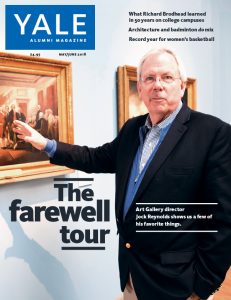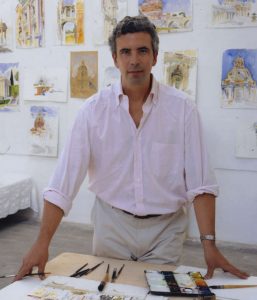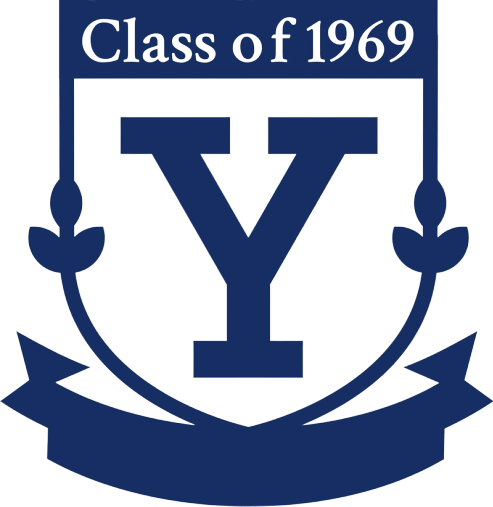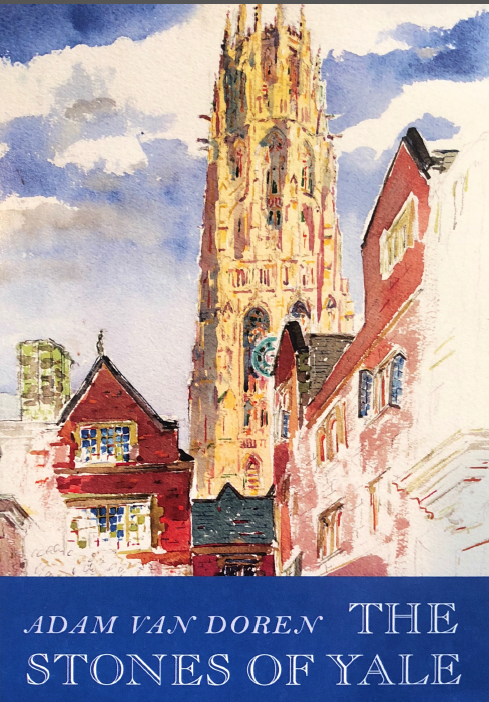Review: Adam Van Doren’s The Stones of Yale
[av_one_half first min_height=” vertical_alignment=” space=” custom_margin=” margin=’0px’ padding=’0px’ border=” border_color=” radius=’0px’ background_color=” src=” background_position=’top left’ background_repeat=’no-repeat’ animation=” mobile_breaking=” mobile_display=”]
[av_textblock size=” font_color=” color=” av-medium-font-size=” av-small-font-size=” av-mini-font-size=” admin_preview_bg=”]
by Arn Welles (’69, JE)
An early June visit to New Haven resulted in the purchase of a wonderful, new book called The Stones of Yale by Adam Van Doren.

First, some background: The inspiration for this visit was the cover story in last month’s Yale Alumni magazine. In “The Farewell Tour,” Jock Reynolds, the highly regarded and retiring Director of the Yale Art Gallery selected a dozen works of art and explained why each was so significant.
What better way to spend an afternoon than to view the same works of art with Jock’s comments in hand? Jock is a Yale legend and oversaw a $135 million renovation which brought the Gallery to its current state of magnificence.
After touring the Gallery, I walked down Chapel Street to check out a new hotel called The Study at Yale. (It was called The Midtown Motor Inn in our day.) The Study is right next to the old Duncan Hotel, which is being completely renovated.

In The Study’s lobby, I got talking to Adam Van Doren, an accomplished artist, an art teacher and a Fellow at Yale, about his latest book, The Stones of Yale.
His book contains 30 chapters, each of which is devoted to one building on Yale’s campus. It provides that building’s history as well as one or two evocative watercolors, which Van Doren created. I found that the paintings captured the buildings’ essence and brought back many memories of our times on the campus.
For those with an interest in specific buildings, I have included a list of the 30 buildings he covered at the end of this post.
Van Doren writes as well as he paints, too. The book is not only entertaining, it’s informative. If you do take the time to read the entire book, you will be able to answer the following questions and many more about the Yale campus:
- Where did the name Mory’s come from?
- Who founded the Yale Art Gallery?
- Who was the architect of Harkness Tower, Sterling Library and Law School, the NYC Yale Club and many Yale Colleges?
- Which College is split in two?
- Which College is named after, and got its nickname from, a preacher who said: “The God that holds you over the pit of hell, much as one holds a spider, or some loathsome creature over the fire, abhors you, and is dreadfully provoked.”
See below for answers.
Adam Van Dorn studied architecture at Columbia under Robert A. M. Stern, the former Dean of Yale’s Architecture School. Adam comes from a family of accomplished writers and painters. Stern wrote an introduction to this book as did Henry “Sam” Chauncey, Jr., who was assistant to Kingman Brewster while we were there. These two introductions should not be skipped as they concisely describe how Yale’s campus came to be.
In addition to the lovely watercolors, what I liked about the book was that it provided key information about the development of Yale’s campus, its principal decision makers and architects and how the buildings relate or don’t to each other. More importantly though, Adam conveyed how the buildings made the people who lived in them feel. What was it like to live and study in Jonathan Edwards for example? What do former students remember about these buildings?
Adam’s sources were current and former students, faculty and administrators. Our own Calvin Hill is quoted twice in the book – once regarding John Hersey, his Pierson College Head, and the other when Calvin visited the Yale Bowl for the first time as a high school senior and watched Yale beat Dartmouth.
One minor drawback is the book does not discuss Yale’s two new Colleges – Pauli Murray and Benjamin Franklin.
Recommendation: Buy The Stones of Yale (Amazon preview). In doing so, you will take a journey back in time. You will have an opportunity to reflect on what it was like to live and study on the Yale campus and perhaps on what we were like then and are now. Lux et Veritas!
Answers to questions:
- Frank Moriarty
- John Trumbull
- James Gamble Rogers
- Berkeley, and
- Jonathan Edwards; his sermon also gave JE the “Spiders” nickname.
[/av_textblock]
[/av_one_half][av_one_half min_height=” vertical_alignment=” space=” custom_margin=” margin=’0px’ padding=’0px’ border=” border_color=” radius=’0px’ background_color=” src=” background_position=’top left’ background_repeat=’no-repeat’ animation=” mobile_breaking=” mobile_display=”]
[av_image src=’https://yale1969.org/wp-content/uploads/2018/07/1.-cover.png’ attachment=’15363′ attachment_size=’full’ align=’center’ styling=” hover=” link=’lightbox’ target=” caption=” font_size=” appearance=” overlay_opacity=’0.4′ overlay_color=’#000000′ overlay_text_color=’#ffffff’ animation=’no-animation’ admin_preview_bg=”][/av_image]
[av_image src=’https://yale1969.org/wp-content/uploads/2018/07/2.-sterling-vault.png’ attachment=’15365′ attachment_size=’full’ align=’center’ styling=” hover=” link=’lightbox’ target=” caption=” font_size=” appearance=” overlay_opacity=’0.4′ overlay_color=’#000000′ overlay_text_color=’#ffffff’ animation=’no-animation’ admin_preview_bg=”][/av_image]
[av_image src=’https://yale1969.org/wp-content/uploads/2018/07/3.-fence-300×238.png’ attachment=’15366′ attachment_size=’medium’ align=’center’ styling=” hover=” link=’lightbox’ target=” caption=” font_size=” appearance=” overlay_opacity=’0.4′ overlay_color=’#000000′ overlay_text_color=’#ffffff’ animation=’no-animation’ admin_preview_bg=”][/av_image]
[av_image src=’https://yale1969.org/wp-content/uploads/2018/07/4.-lawrence-hall.png’ attachment=’15362′ attachment_size=’full’ align=’center’ styling=” hover=” link=’lightbox’ target=” caption=” font_size=” appearance=” overlay_opacity=’0.4′ overlay_color=’#000000′ overlay_text_color=’#ffffff’ animation=’no-animation’ admin_preview_bg=”][/av_image]
[av_image src=’https://yale1969.org/wp-content/uploads/2018/07/5.-Harkness.png’ attachment=’15361′ attachment_size=’full’ align=’center’ styling=” hover=” link=’lightbox’ target=” caption=” font_size=” appearance=” overlay_opacity=’0.4′ overlay_color=’#000000′ overlay_text_color=’#ffffff’ animation=’no-animation’ admin_preview_bg=”][/av_image]
[av_image src=’https://yale1969.org/wp-content/uploads/2018/07/6.-sterling-hall-300×222.png’ attachment=’15364′ attachment_size=’medium’ align=’center’ styling=” hover=” link=’lightbox’ target=” caption=” font_size=” appearance=” overlay_opacity=’0.4′ overlay_color=’#000000′ overlay_text_color=’#ffffff’ animation=’no-animation’ admin_preview_bg=”][/av_image]
[av_textblock size=” font_color=” color=” av-medium-font-size=” av-small-font-size=” av-mini-font-size=” admin_preview_bg=”]
Buildings Covered
- The Elizabethan Club
- Mory’s
- Harkness Tower
- Sterling Memorial Library
- The Yale University Art Gallery
- The Yale Fence
- Sterling Law School
- David S. Ingalls Rink
- The Old Campus
- Pierson College
- Betts House
- Sheffield-Sterling-Strathcona
- Berkeley College
- Rudolph Hall
- The Bicentennial Buildings (Freshman Commons and Woolsey Hall)
- Skull and Bones
- Jonathan Edwards College
- Grace Hopper College (formerly Calhoun)
- The Yale Club of New York
- Kroon Hall (Forestry School)
- Davenport College
- The Divinity School
- Beinecke Rare Book and Manuscript Library
- Timothy Dwight College
- Gilder Boathouse
- Yale Center for British Art
- Stoeckel Hall (Music Department)
- The Yale Bowl
- Silliman College
- Branford College
[/av_textblock]
[/av_one_half]

